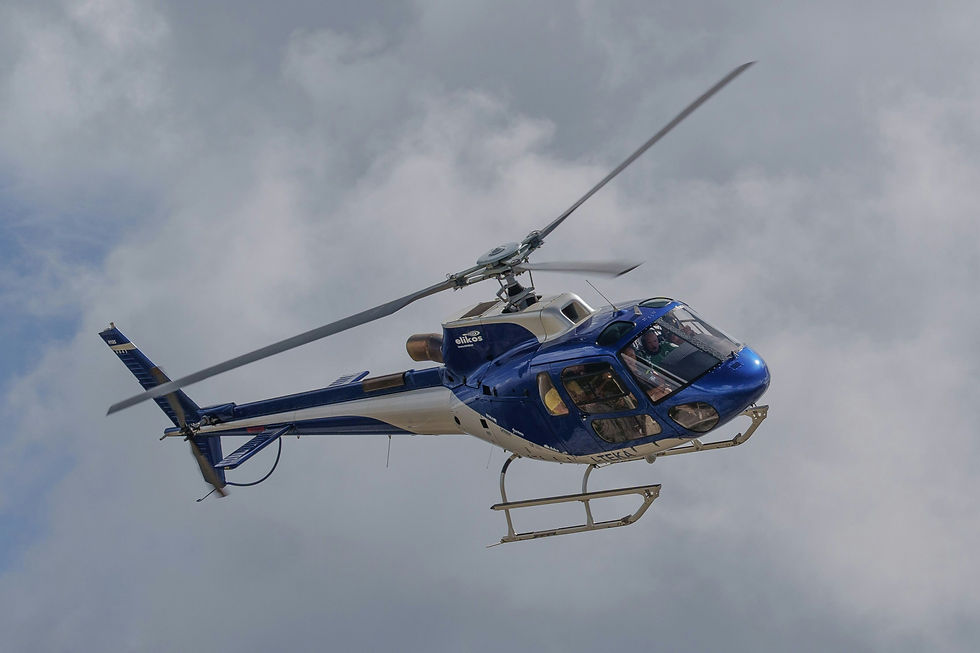Innovations Powering Sustainable Aerial Transport in Grenada
- Glenn Allyn
- Jul 23, 2025
- 4 min read
Grenada’s unique geography plays a critical role in the rise of aerial transport within the island. As a volcanic island characterized by mountainous terrain, dense forests, and winding coastal roads, traditional ground transportation often encounters natural barriers and longer travel times. This challenging landscape has increased reliance on aerial transport options such as helicopters and small aircraft to facilitate faster, more efficient movement of people and goods across the island.
The dispersed population centers and tourism hotspots create demand for flexible and accessible transportation alternatives. Aerial transport fills this gap by offering direct routes that bypass the limitations of road infrastructure, ensuring timely connections between the island’s capital, St. George’s, northern beaches, and more remote locations. This mode of transport enhances Grenada’s overall connectivity, making it easier for residents and visitors to navigate the island’s diverse regions.
Infrastructure development tailored to aerial transport has been a key focus of Grenada’s government and private sector. The modernization of Maurice Bishop International Airport and the establishment of several heliports and smaller airfields have laid the foundation for this sector’s expansion. These facilities support increased aircraft operations, maintenance, and passenger services, reinforcing the island’s capacity to accommodate growing aerial traffic.
Tourism-Driven Demand Fuels Sector Growth
Tourism is the primary catalyst behind the rapid expansion of aerial transport in Grenada. The island’s appeal as a luxury destination, renowned for its unspoiled beaches, spice plantations, and vibrant culture, attracts travelers seeking exclusive and efficient travel experiences. Helicopter tours and private charters have become integral components of the tourism offering, delivering scenic flights that showcase Grenada’s breathtaking landscapes from an aerial perspective.
For high-net-worth visitors and those with limited time, aerial transport presents a valuable option to bypass congested or lengthy road journeys. Resorts and travel agencies increasingly incorporate helicopter transfers into their premium packages, enhancing guest convenience and satisfaction. These services connect key points such as the airport, luxury resorts, and private villas, enabling tourists to maximize their leisure time and enjoy seamless mobility.
The demand for aerial transport has also encouraged operators to diversify their services, including sunset flights, island-hopping excursions, and aerial photography tours. These experiences capitalize on Grenada’s natural beauty while offering unique recreational opportunities. As the island’s reputation grows internationally, the tourism sector’s reliance on aerial transport is expected to strengthen further, supporting a sustainable cycle of economic benefit.
Economic Benefits and Business Expansion Through Aviation
Beyond tourism, the growth of aerial transport has significant positive effects on Grenada’s broader economy. The expansion of aviation services has created new business opportunities across multiple sectors, including aircraft maintenance, pilot training, and logistics. Local entrepreneurs and foreign investors have shown increasing interest in establishing helicopter charter companies, flight schools, and specialized air cargo operations.
Investment in aerial transport infrastructure has translated into job creation and skills development for Grenadian workers. These economic benefits extend into related industries such as hospitality, real estate, and retail, which benefit from improved accessibility and the influx of tourists and business travelers. Furthermore, enhanced air connectivity supports Grenada’s strategic initiatives to attract foreign direct investment, particularly in sectors requiring reliable and flexible transport options.
The Citizenship by Investment program has also played a notable role in this dynamic. Wealthy investors often seek destinations that offer high standards of transport and connectivity, making Grenada’s expanding aerial network a competitive advantage. As a result, the island’s aerial transport sector serves immediate mobility needs and strengthens its attractiveness as an investment destination, encouraging long-term economic growth.
Technological Innovations Supporting Sustainable Development
Technological progress in aviation has been a driving force behind the growth of aerial transport in Grenada. Modern helicopters and small aircraft are increasingly equipped with advanced navigation, safety, and communication systems that enhance operational reliability in the Caribbean’s weather conditions. These innovations enable operators to offer safer, more efficient, and more comfortable flight experiences.
In line with global trends toward environmental responsibility, Grenada’s aerial transport sector is embracing sustainable practices. Operators are exploring using low-emission engines, alternative fuels, and noise reduction technologies to minimize environmental impact. These efforts align with Grenada’s commitment to preserving its natural heritage and promoting eco-tourism, appealing to an international clientele that values green travel options.
The adoption of drone technology is also on the horizon, promising to complement traditional aerial transport services. Drones could revolutionize cargo delivery, emergency medical response, and environmental monitoring, overcoming logistical challenges associated with Grenada’s rugged terrain. This integration of innovative technologies positions Grenada at the forefront of sustainable aviation development in the Caribbean region.
Future Prospects: Regional Integration and Enhanced Connectivity
Aerial transport in Grenada is expected to evolve as a cornerstone of regional integration and economic diversification. The island aims to strengthen air links with neighboring Caribbean countries, facilitating greater movement of people, goods, and services throughout the Eastern Caribbean. This regional connectivity will support tourism and bolster trade and cultural exchange.
Expanding inter-island helicopter routes and specialized air freight services will improve supply chain resilience and reduce reliance on sea transport, which can be slower and less predictable. Moreover, as Grenada invests in upgrading heliports and airport facilities, it will be better positioned to accommodate increased air traffic, including private jets and emergency services.
The emergence of innovative aviation systems, including real-time tracking and digital booking platforms, will likely enhance operational efficiency and customer convenience. As these technologies mature, aerial transport will become more accessible and integrated into daily life on the island, supporting economic growth and improving the quality of life for residents.
Overall, the continued development of aerial transport reflects Grenada’s strategic approach to leveraging its geographic assets and technological advancements. This growth story demonstrates how innovative transportation solutions can transform an island nation’s connectivity, economy, and global appeal in the 21st century.



Comments